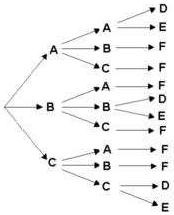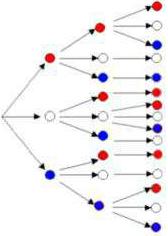Subscribe to our ▶️ YouTube channel 🔴 for the latest videos, updates, and tips.
Worksheet on Simple Probability
Practice the questions given in the worksheet on simple probability to get the idea how to find the probability of different events given in the tree diagram problems.
Read the probability questions carefully to match the outcome with its probability.
1.
The tree diagram above represents three events. In the first event either an A, B, or C is chosen. In the second event either an A, B, or C is chosen. In the third event either a D, E, or F is chosen.
Match the outcome with its probability:
|
(i) The second letter is a C
(ii) The first or second letter is an A (iii) The last letter chosen is a D (iv) First 2 letters chosen are both A (v) All three letters are the same (vi) The first letter is not an A (vii) ADD |
(a) 6/12 (b) 0/12 (c) 3/12 (d)2/12 (e) 1/12 (f) 8/12 (g) 4/12 |
2.
The tree diagram above represents three events. In the first event either a Red, White, or Blue circle is chosen. In the second event either a Red, White, or Blue circle is chosen. In the third event either a Red, White, or Blue circle is chosen.
Match the outcome with its probability:
|
(i) The second circle is white (ii) All three circles are red (iii) Exactly two circles are the same (iv) At least two circles are the same (v) The first circle is not red (vi) The first two circles are blue (vii) The third circle is blue |
(a) 10/15 (b) 4/15 (c) 5/15 (d) 3/15 (e) 1/15 (f) 12/15 (g) 15/15 |
The worksheet on simple probability provides two different types of questions on tree diagram. Solve the questions one by one to match the outcome with its probability.
From Worksheet on Simple Probability to HOME PAGE
Didn't find what you were looking for? Or want to know more information about Math Only Math. Use this Google Search to find what you need.




New! Comments
Have your say about what you just read! Leave me a comment in the box below. Ask a Question or Answer a Question.